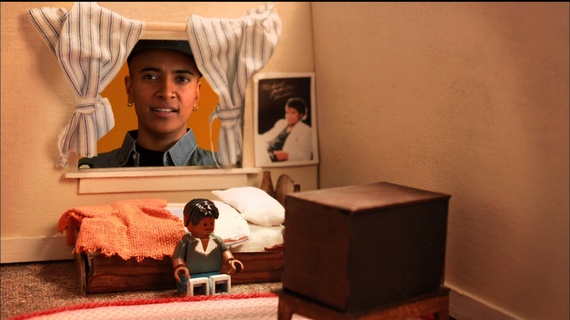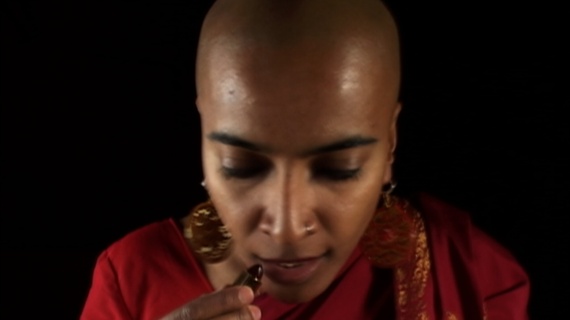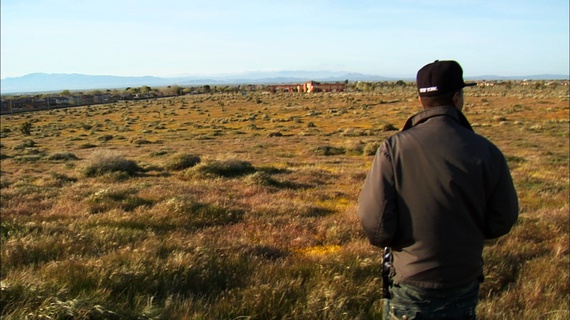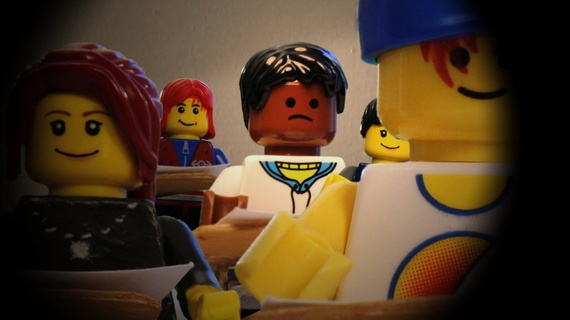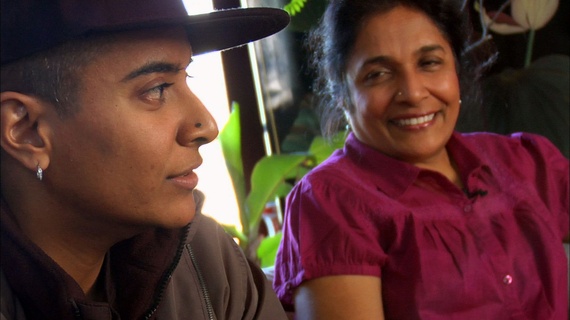Performing Girl is a short documentary about D'Lo, a queer, transgender, Tamil Sri Lankan American political theater actor, writer, director, music producer and comic who got his start at age 11, performing for his family and classmates in the desert town of Lancaster, Calif. Drawn in by the film's unique mix of Lego animations, home movies, family snapshots, interviews and clips from his comedic performances, I decided to learn more about Performing Girl from D'Lo (not an easy guy to pin down as he jumps between tours!) and the film's creator, Crescent Diamond.
D'Lo (photo credit: Crescent Diamond)
Mitch Kellaway: Can you give us a bit of background on Performing Girl?
Crescent Diamond: The film begins with a story about how D'Lo ran away from home because he felt that he would not survive in Lancaster being queer. He [then] realized he would have to perform being a "girl" in order to survive his adolescence. This performance included wearing girls' clothes and changing the way he walked and talked. Twenty years later, D'Lo looks back on this time period and explains that this "performance" was his theater training and contributed powerfully to his artistic vision.
Kellaway: D'Lo, can you elaborate on how deliberately "performing girl" as a teenager contributes to your work today?
D'Lo: I do a lot of female/women characters in all my solo shows, and with all characters, regardless of gender, I love to present them onstage in full costume. As an actor, I try to honor my characters/their stories as if they were me/mine. It is the training I learned to stand by, as I had to perform being a girl in order to truly convince others that I was not queer in any way. As an actor, this is the only training I had for so long, as every acting class I tried to take was a hostile environment for gender-nonconforming and transgender people.
D'Lo preparing to perform a female character (photo credit: Crescent Diamond)
Kellaway: Crescent, how did you arrive at the idea to create a documentary about D'Lo, and in particular his performances of "girl"?
Diamond: I saw D'Lo perform a short monologue at the Butch Voices Conference in Oakland, 2010. He started out playing the "Amma" character [based on his mother], dressed in a sari with a long wig and makeup, and then transitioned into an autobiographical monologue by taking off the costume and wig to portray his masculine self and reaction to what his mother has just said. I was blown away by his performance, particularly in the way that he was able to portray his mother with so much love and compassion, while simultaneously revealing the anger and frustration that he was feeling about her lack of understanding.
Watching Ramble-Ations: A One D'Lo Show, I was introduced to his childhood story. Part of my research process included interviewing D'Lo playing the "Amma" character who revealed more details about his experiences when he hit puberty. I decided to focus on that part of his story because I realized that whether we grow up as transgender or cisgender, we all have a point in our adolescence when we understand that we aren't going to be treated just as a "kid" or a "person," but that we now have to dress and behave like a "girl" or "boy" or there will be social consequences.
D'Lo performing his show D'FunQT (photo credit: Crescent Diamond)
Kellaway: In the film we get to see clips of you, D'Lo, performing "Amma" [from your stage shows Ramble-Ations: A One D'Lo Show and D'FunQT], where you act as your mother responding to you coming out first as gay and then as transgender, and then conversations between you and both your parents. What were your thoughts behind this approach?
D'Lo: I don't think I had thought of it as an approach, but I can say that because I feel that the coming-out stories are our most powerful tool as queer people, I made sure to construct my theatrical journeys using pillars and in a linear timeline. My pillars in which I weave in my coming-of-age-as-a-queer-person stories allow me to share how my views on life, friendship, love and social justice had morphed as my support systems changed.
Kellaway: The film addresses coming out not only at home but in the community of Lancaster, Calif., as part of the Sri Lankan diaspora. Can you talk a bit about how your culture and community interacted with your evolving understandings of your gender?
D'Lo: Aside from the two or three aunties or uncles who knew that my boyish ways weren't going to change and that I'd be the "different" one, the majority of the community didn't know how to accept it, I think partly because my parents didn't know how, and partly because it was foreign to them. Because it was foreign, they could also chalk it up to me "acting out" and not see it related to my gender presentation.
D'Lo looks across a desert in his hometown (photo credit: Crescent Diamond)
Kellaway: Crescent, how do you see your stylistic choices informing the film's larger messages?
Diamond: The style of the film is best described as "camp," as it uses comedy and exaggeration to explore the feelings of confusion, isolation and fear that D'Lo was struggling with in early adolescence. It also suggests that everything within the film can be considered a performance. I created the Lego animations in order to represent D'Lo's memories of childhood and his mindset at the time.
We use Legos, a toy that many perceive as "genderless," since boys and girls equally love them, and the young D'Lo was a big fan. The Lego scenes recreate the feeling of isolation and fear that precipitated D'Lo's decision to begin "performing girl." The archival video and photos bring to life his vibrant personality, his "boy" look and behavior, and how safe and loved he felt before these traumatic events. The home video, snapshots and Legos remind many people of their pleasant childhood memories, and the priceless innocence that precedes adolescence.
Lego scenes capture fear and isolation (photo credit: Crescent Diamond)
Kellaway: Crescent, how has your own identity informed the creation of Performing Girl?
Diamond: I identify as a queer, femme, white (Eastern European), cisgender woman. When I first heard D'Lo describe how he felt when he hit puberty, I instantly related, even though my actual experience was vastly different. I realized that when I first got my period and hit puberty, I was also expected to start "performing girl," meaning that I was no longer just a "kid" but I was now expected to behave and dress in a very specific way, as dictated by our heteronormative culture.
As a queer femme, I now feel that I have a choice in how I think about my gender identity and how I present my gender expression, and I am also aware that this choice is derived from my privileged position as a cisgender, white, middle-class woman living in the Bay Area. I also was very aware of my position as a white cisgender filmmaker representing a transgender person of color. My identity (and morphology) automatically grants me privileges in this culture, and the power of representation that I wield as a filmmaker comes with a lot of responsibility. I worked hard to make sure that I was as respectful of D'Lo and his family as possible, and he also had final say about what was included in the film.
D'Lo with his mother (photo credit: Crescent Diamond)
Kellaway: How do you see the film contributing to how audiences -- both trans and cisgender -- perceive and talk about trans people?
Diamond: There is a giant dearth of transgender representation in film and television, particularly of people of color, and stories that are told in an authentic, respectful, and inspiring manner. Too often the stories that are represented end in tragedy and/or simply focus on medical transition. I think queer, trans and general audiences are hungry for stories about transgender people of color that show them thriving and are not simply focused on their "difference."
As I was making the film and telling people about D'Lo, I noticed that most people were very confused about his gender identity (which is "transgender," not "trans man") and were mostly interested in whether he had a medical transition. It's my intention to challenge these audiences to begin to think about transgender folks as people just like us cisgender folks who have challenges and triumphs, and that any medical procedures that they may or may not have had are not any of our business.
D'Lo: I hope that this film allows people to share their similar stories of growing up with others. In the least, I hope this film forces people to talk and others to listen.
To learn more about D'Lo and Performing Girl, visit D'Lo's website, dlocokid.com, and the film's websites, performinggirl.com and facebook.com/performinggirl.
